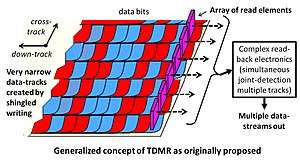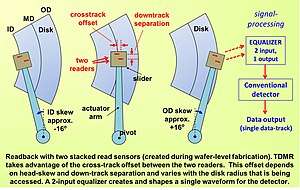Two-dimensional magnetic recording
Two-dimensional magnetic recording (TDMR) is a novel technology recently introduced in hard disk drives (HDD) used for computer data storage. Most of the world's data is recorded on HDDs, and there is continuous pressure on manufacturers to create greater data storage capacity in a given HDD form-factor and for a given cost. In an HDD, data is stored using magnetic recording on a rotating magnetic disk and is accessed through a write-head and read-head (or read-element). TDMR allows greater storage capacity by advantageously combining signals simultaneously from multiple read-back heads to enhance the recovery of one or more of data-tracks. In this manner, data can be stored with higher areal-density on the disks thus providing higher capacity in each HDD.[1][2][3] TDMR is a read-back technology and thus applies equally well to future recording (writing) technologies such as Heat-Assisted Magnetic Recording (HAMR) and Microwave-Assisted Magnetic Recording (MAMR).[4]

Overview
The TDMR approach arose from a working group set up under INSIC to explore alternative future storage technologies.[5] In the initial concept, the data-tracks were assumed to be very narrow tracks created by shingled recording and subject to considerable mutual interference. The read-heads were assumed to be each centered over a corresponding data-track and a joint detector would optimally recover data from several tracks simultaneously.[6][7] The technique was viewed as akin to PRML in providing gains similar to and in addition to the gains from PRML but operating across the tracks rather than down the track. A relatively large body of subsequent work has explored this configuration primarily from the perspective of signal processing.[8][9][10][11][12] However, the technical challenge of creating an array of closely spaced read-heads and the complexity of jointly detecting data simultaneously on several tracks are both considerable.
Implementations

In 2017, M. Fatih Erden announced at the TMRC conference that Seagate had been shipping HDDs with TDMR since earlier that year.[13][14] This was followed by Western Digital in 2018[2][15] and Toshiba in 2019.[16][17]. These actual first implementations of TDMR are much simpler and very different to the scenario originally envisioned above. Current implementations recover only a single track using a read head with just two read-elements stacked one above the other (i.e. downtrack) and rely on the skew arising from the use of a rotary actuator to create some cross-track separation between the sensors.[18] This TDMR approach is being applied to both Shingled (SMR) and conventional PMR HDDs.[19] The gains achieved are quite modest (6 to 12%) but are expected to increase going forward as more complex schemes are implemented[20]
In concept, there is little change to the read electronics except that the equalizer that shapes the signal prior to detection now has two inputs and must be appropriately optimized.[21] However, In practice, there is significant added complexity in the read electronics and in the setup process during manufacturing. This complexity is associated with optimization of the equalization (waveform shaping) and timing recovery for the dynamically varying offtrack conditions - further complicated by the cross-track offset between readers that varies with radius[22][23]
References
- A. Shilov speaking with Mark Re, Seagate CTO, "The evolution of hdds in the near future", AnandTech: 6 July, 2016
- T. Coughlin, "Two-dimensional Magnetic Recording and other HDD news", Forbes: Enterprise Tech., Apr 29, 2018
- R. LuTchessi, "Two-Dimensional Magnetic Recording (TDMR)", Silverton Consulting blog, Mar. 5th, 2014
- C. Mellor, "MAMR Mia! Western Digital's 18TB and 20TB microwave-energy hard drives out soon", The Register, Sept 4, 1019
- R. Wood, "Shingled Writing and Two-Dimensional Magnetic Recording", INSIC Annual Meeting, Alternative Storage Technologies 2009: You Want to Build What?, 5 Aug. 2009
- R. Wood, M. Williams, A. Kavcic, J. Miles, "The Feasibility of Magnetic Recording at 10 Terabits per Square Inch on Conventional Media", IEEE Trans. Magn., vol. MAG-45, No. 2, pp. 917-923, Feb. 2009
- R. Wood, "Shingled Magnetic Recording and Two-Dimensional Magnetic Recording", presented at IEEE Magnetics Society, Santa Clara Valley Chapter, Oct. 19th, 2010
- Krishnan, Radhakrishnan, Vasic, Kavcic, Ryan and Erden. Two-Dimensional Magnetic Recording: Read Channel Modeling and Detection. IEEE. Trans on Magnetics, 45:3830-3836, 22 Sept., 2009. 2009 (Best Student Paper” award for 2010 by IEEE Data Storage Committee)
- K. Chan, R. Radhakrishnan, K. Eason, M. Elidrissi, J. Miles, B. Vasic, A. Krishnan, "Channel Models and Detectors for Two-Dimensional Magnetic Recording", IEEE Trans. Magn., Vol. 46, No. 3, pp. 804 - 811, Mar. 2010
- A. Kavcic, X. Huang, B. Vasic, W. Ryan, F. Erden, "Channel Modeling and Capacity Bounds for Two-Dimensional Magnetic Recording", IEEE Trans. Magn., Vol. 46, No. 3, pp. 812-818, 17 Feb., 2010
- R. Victora, S. Morgan, K. Momsen, E. Cho, F. Erden, "Two-Dimensional Magnetic Recording at 10Tbits/in2", IEEE Trans. Magn., Vol., 48 No. 5, pp. 1697 - 1703, 19 April 2012
- S. Garani, L. Dolecek, J. Barry ; F. Sala ; B. Vasić, "Signal Processing and Coding Techniques for 2-D Magnetic Recording: An Overview", IEEE Proceedings, Vol. 106, No. 2, pp. 286-318, Feb. 2018
- M. Kief, I. Tagawa, "The 28th Magnetic Recording Conference (TMRC 2017)", IEEE Trans. Magn., Vol. 54, No. 2, Feb. 2018 0200101
- Tom's Hardware: P. Alcorn, "Seagate Announces 14TB Barracuda Pro, IronWolf, and IronWolf Pro", Sept. 10th, 2018
- Western Digital Ultrastar HC530 data sheet
- AnandTech: Toshiba at CES2019: Worlds first 16TB TDMR HDD Debuts
- M. Abe & T. Hara, "Nearline TDMR HDDs with Industry’s Largest Capacity of 16 Tbytes", Toshiba Technology Review, Vol. 74., No. 6, pp. 8-11, Nov. 2019
- J. Coker, "Opportunities and Challenges for Two-Dimensional Magnetic Recording", IEEE Distinguished Lecture, May 7th, 2015
- "Non-shingled and ready to mingle: WDC catches up with 14TB disk rivals", C. Mellor, The Register, 18 Apr, 2018
- S. Dahandeh, F. Erden, R. Wood, "Areal-Density gains and Technology Roadmap for Two-Dimensional Magnetic Recording", TMRC 2015 Digest Book, paper F1, 17-19 Aug., 2015
- R. Wood, R. Galbraith, J. Coker, "Two-Dimensional Magnetic Recording (TDMR): Progress and Evolution", IEEE Trans. Magn., Vol. 51, No. 4, pp. 3100607, April 2015
- M. Oberg and N. Nagare, "Two Dimensional Magnetic Recording System, Devices, and Methods", US Patent 9728221 Aug. 8, 2017
- G. Mathew, S. Dziak ; K. Worrell, J. Singleton, B. Wilson, H. Xia, "2-D Equalization With Location Diversity and Pre-Adaptation to Handle Off-Track Variation in Array-Reader-Based Hard Disk Drives", IEEE Trans. Magn., Vol 54, No. 2, p. 3000307